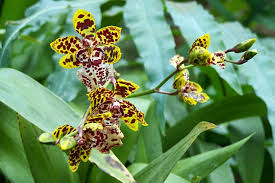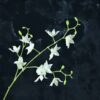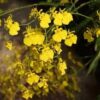# Caring for Dancing Lady Orchids (*Oncidium*) Before and After Exhibition: A Comprehensive Guide

Dancing Lady Orchids, scientifically known as *Oncidium*, are admired for their unique beauty and graceful appearance. When preparing these stunning orchids for an exhibition, meticulous care is essential both before and after the event to ensure they look their best and maintain their health. This comprehensive guide will delve into effective strategies for caring for *Oncidium* orchids, covering everything from pre-exhibition preparation to post-exhibition maintenance.
## Table of Contents
1. [Understanding *Oncidium* Orchids](#understanding-oncidium-orchids)
– 1.1 [Characteristics of *Oncidium* Orchids](#characteristics-of-oncidium-orchids)
– 1.2 [Growth Habits and Environmental Needs](#growth-habits-and-environmental-needs)
2. [Pre-Exhibition Care](#pre-exhibition-care)
– 2.1 [Assessing Orchid Health](#assessing-orchid-health)
– 2.2 [Environmental Adjustments](#environmental-adjustments)
– 2.3 [Grooming and Presentation](#grooming-and-presentation)
– 2.4 [Nutritional Preparation](#nutritional-preparation)
3. [Transporting *Oncidium* Orchids](#transporting-oncidium-orchids)
– 3.1 [Preparing for Transport](#preparing-for-transport)
– 3.2 [Safe Transport Practices](#safe-transport-practices)
4. [Exhibition Day Care](#exhibition-day-care)
– 4.1 [Setting Up at the Exhibition](#setting-up-at-the-exhibition)
– 4.2 [Watering and Maintenance](#watering-and-maintenance)
5. [Post-Exhibition Care](#post-exhibition-care)
– 5.1 [Unpacking and Assessing Condition](#unpacking-and-assessing-condition)
– 5.2 [Re-establishing Environmental Conditions](#re-establishing-environmental-conditions)
– 5.3 [Long-Term Care](#long-term-care)
6. [Troubleshooting Common Issues](#troubleshooting-common-issues)
7. [Conclusion](#conclusion)
## 1. Understanding *Oncidium* Orchids
### 1.1 Characteristics of *Oncidium* Orchids
Dancing Lady Orchids are native to Central and South America, where they grow as epiphytes in humid environments. Known for their intricate flower shapes, which resemble a dancing figure, *Oncidium* orchids come in various colors, including yellow, orange, and brown, making them popular among orchid enthusiasts.
### 1.2 Growth Habits and Environmental Needs
*Oncidium* orchids thrive in warm, humid conditions. They typically grow from pseudobulbs that store water and nutrients and feature long, arching leaves. To keep these orchids healthy, it’s important to provide adequate light, moisture, and nutrition.
## 2. Pre-Exhibition Care
Proper preparation is vital to ensure that your *Oncidium* orchids look their best for the exhibition. This section outlines essential care practices in the lead-up to the event.
### 2.1 Assessing Orchid Health
Before preparing your orchids for an exhibition, assess their overall health:
– **Visual Inspection**: Check for any signs of disease, pests, or damage to the leaves and flowers. Look for yellowing leaves, spots, or wilting.
– **Root Condition**: Gently remove the orchid from its pot to inspect the roots. Healthy roots should be firm and white or green. Remove any rotten or mushy roots.
– **Pseudobulb Check**: Ensure that the pseudobulbs are firm and plump, indicating they have sufficient water reserves.
### 2.2 Environmental Adjustments
To enhance the orchids’ health before the exhibition, consider making the following environmental adjustments:
– **Lighting**: Ensure your orchids receive bright, indirect light for at least 12 hours a day. If needed, supplement natural light with grow lights.
– **Humidity**: Maintain humidity levels between 40% to 60%. Use a humidity tray or mist the plants regularly to create a suitable environment.
– **Temperature**: Keep the temperature within the ideal range of 70°F to 85°F (21°C to 29°C) during the day and 55°F to 65°F (13°C to 18°C) at night.
### 2.3 Grooming and Presentation
Aesthetic grooming is crucial to prepare your *Oncidium* orchids for exhibition:
– **Cleaning Leaves**: Wipe the leaves gently with a damp cloth to remove dust and debris. This not only enhances their appearance but also improves photosynthesis.
– **Deadheading Flowers**: Remove any spent or damaged flowers to focus the plant’s energy on healthy blooms.
– **Supporting Flower Spikes**: If your orchids have tall flower spikes, consider using stakes or supports to keep them upright and prevent damage.
### 2.4 Nutritional Preparation
Proper nutrition is vital for ensuring your *Oncidium* orchids are at their best for the exhibition:
– **Fertilization**: About two weeks before the exhibition, use a balanced orchid fertilizer (30-10-10) at half strength every two weeks to promote healthy growth and blooms.
– **Watering**: Water your orchids thoroughly but allow the substrate to dry slightly between waterings. This will help prevent root rot while ensuring adequate hydration.
## 3. Transporting *Oncidium* Orchids
Transporting your *Oncidium* orchids to the exhibition requires careful planning to ensure their safety and health during transit.
### 3.1 Preparing for Transport
Before the day of transport, take these steps:
– **Watering**: Water your orchids a day or two before transport to ensure they are hydrated but avoid overwatering right before the event.
– **Stabilizing Plants**: If the orchids are in pots, secure the plants to prevent movement during transport. You can use packing material or bubble wrap around the pots for extra cushioning.
### 3.2 Safe Transport Practices
When transporting your orchids, follow these guidelines to ensure they remain safe:
– **Transport Method**: Use a sturdy box or container that can hold the pots securely. Ensure it has adequate ventilation to allow airflow.
– **Avoid Temperature Extremes**: Keep the orchids at a stable temperature during transport. Avoid leaving them in hot cars or exposing them to cold drafts.
– **Minimize Movement**: Drive carefully to minimize jostling and vibrations that could damage the plants.
## 4. Exhibition Day Care
On the day of the exhibition, your *Oncidium* orchids will require specific care to maintain their appearance and health.
### 4.1 Setting Up at the Exhibition
Once you arrive at the exhibition venue, follow these steps to set up your orchids:
– **Choose the Right Location**: Find a spot with bright, indirect light and good air circulation for your orchids. Avoid direct sunlight, which can cause stress.
– **Display Aesthetics**: Arrange the orchids in a visually appealing manner. Use decorative pots or stands to enhance their presentation.
### 4.2 Watering and Maintenance
During the exhibition, monitor your orchids closely:
– **Watering**: If the exhibition lasts for several hours or days, check the substrate’s moisture level. Water lightly if the top inch feels dry, but avoid overwatering.
– **Regular Checks**: Periodically check for signs of wilting, pests, or damage. Address any issues immediately to maintain their health.
## 5. Post-Exhibition Care
After the exhibition, it’s crucial to care for your *Oncidium* orchids to ensure they recover and continue to thrive.
### 5.1 Unpacking and Assessing Condition
Once you return home, unpack your orchids carefully:
– **Inspect for Damage**: Check for any signs of stress or damage that may have occurred during transport. Look for droopy leaves or wilting flowers.
– **Gently Clean**: Remove any debris or dust that may have accumulated during the exhibition.
### 5.2 Re-establishing Environmental Conditions
To help your orchids recover after the exhibition, restore their ideal environmental conditions:
– **Return to Normal Lighting**: Gradually reintroduce your orchids to their usual light conditions, avoiding sudden changes.
– **Humidity and Temperature**: Ensure that the humidity and temperature levels return to the optimal ranges for *Oncidium* orchids.
### 5.3 Long-Term Care
Continue to provide regular care to promote long-term health:
– **Watering Routine**: Resume your normal watering routine, ensuring the substrate dries slightly between waterings.
– **Fertilization**: After a week or so, resume fertilization with a balanced orchid fertilizer, following a regular schedule to promote new growth.
## 6. Troubleshooting Common Issues
Even with careful preparation and care, you may encounter challenges with your *Oncidium* orchids. Here are some common issues and their solutions:
### 6.1 Wilting Leaves
If your orchids exhibit wilting leaves after the exhibition, it could be due to:
– **Underwatering**: Ensure you are watering adequately. Check the moisture level and water as needed.
– **Overwatering**: Conversely, too much water can lead to root rot. Check the roots for any signs of decay and adjust your watering habits.
### 6.2 Flower Drop
Premature flower drop can occur due to:
– **Stress from Transport**: Provide a stable environment to help the orchids recover from transport stress.
– **Sudden Environmental Changes**: Avoid drastic changes in temperature, light, or humidity levels.
### 6.3 Pest
Infestations
Pests such as aphids or spider mites can sometimes appear after exhibitions:
– **Regular Inspections**: Routinely check your orchids for pests and treat infestations with appropriate insecticides or organic remedies.
– **Preventative Measures**: Maintain good air circulation and humidity to deter pest problems.
## 7. Conclusion
Caring for Dancing Lady Orchids before and after an exhibition involves a blend of preparation, environmental adjustments, and ongoing maintenance. By assessing their health, making necessary environmental changes, and providing proper care throughout the exhibition process, you can ensure that your *Oncidium* orchids not only shine during the event but also continue to thrive in your care afterward. With patience and dedication, you will be rewarded with vibrant blooms and the joy of cultivating these exquisite orchids in your home.

